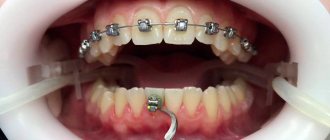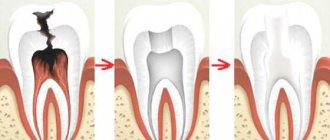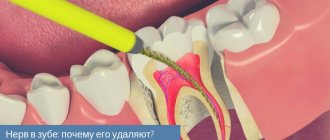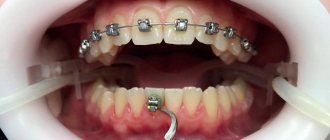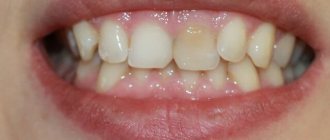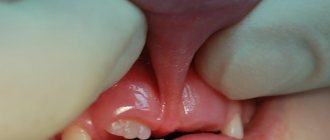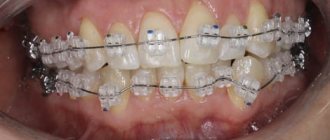What is local anesthesia
The main distinguishing feature of local anesthesia is that the person remains conscious during its effect. This type of anesthesia acts on receptors that are located below chest level. In addition to complete anesthesia, local anesthesia eliminates other tactile sensations, including temperature, pressure on tissue, or stretching.
Local anesthesia is possible in the following areas:
- on the surface of the mucous membranes of various organs - trachea, larynx, bladder, bronchi, and so on;
- in the thickness of tissue - bone, muscle or soft;
- in the direction of the nerve root extending beyond the boundaries of the spinal cord membrane.
- in impulse-conducting nerve cells of the spinal cord.
The main goal of local anesthesia is to block the occurrence of impulses and their transmission while maintaining consciousness.
When is it reasonable to treat teeth under anesthesia?
In modern dentistry, anesthesia is often used not only for complex and lengthy operations, but also for routine dental treatment, grinding for dentures, tooth extraction, and in pediatric dentistry. However, it makes sense to use both general anesthesia and sedation in certain cases and for certain patient conditions:
- If long-term and complex treatment is planned (removal of several teeth at a time, bone grafting operations);
- If the patient suffers from a serious form of dental phobia or dentophobia (fear of the dentist and dental instruments);
- If the patient has diseases associated with an irresistible gag reflex, involuntary nervous convulsions;
- If the patient is allergic to local anesthetic drugs.
In dentistry, patients do not remain in the hospital after general anesthesia, but may well go home after
Types of local anesthesia
In medicine, there are the following types of anesthesia, differing in some characteristics and scope of application:
- terminal;
- infiltration;
- regional;
- intravascular.
Each type has a list of indications and contraindications that must be taken into account when conducting them.
Terminal anesthesia
This type is also known as topical or surface anesthesia. The main areas of application are dentistry, gastroenterology and proctology. Terminal local anesthesia (anesthesia) differs from other types in the method of administration: anesthetics in the form of a spray, gel or ointment are applied to the surface of the skin or mucous membranes.
In proctology, local anesthetic gels and sprays (Katetdzhel, Lidochlor, Lidocaine, etc.) are used during proctological examinations and diagnostic procedures: rectal examination, anoscopy, sigmoidoscopy. The examination becomes virtually painless. Also, local anesthesia in proctologists is used during certain medical procedures: latex ligation of hemorrhoids, sclerotherapy of hemorrhoids, infrared coagulation of internal hemorrhoids, as well as biopsy from the rectum.
Infiltration anesthesia
It is used in dentistry and surgery, and involves the introduction of special solutions into soft tissues. The result of the procedure, in addition to a pronounced anesthetic effect, is an increase in pressure in the tissues, and, as a result, a narrowing of the blood vessels in them.
Regional anesthesia
This type involves the introduction of an anesthetic near large nerve fibers and their plexuses, resulting in pain relief in localized areas. It is divided into the following types of local anesthesia:
- conduction, with the introduction of drugs near the trunk of a peripheral nerve or nerve plexus;
- spinal, with the introduction of drugs into the space between the membranes of the spinal cord and “turns off” pain receptors over a large area of the body;
- epidural anesthesia, with the introduction of drugs into the space between the spinal cord and the walls of the spinal canal through a special catheter.
Intravascular anesthesia
It is used mainly for surgical interventions on the extremities. Administration of drugs is possible only with the application of a hemostatic tourniquet. The anesthetic is injected into a blood vessel located near the nerve responsible for the sensitivity of the limb in the area below the injection site.
In recent years, due to the emergence of more effective local anesthetics, the number of proctological operations performed using local anesthetics has increased significantly. In addition, our specialists have developed a method of combined anesthesia - a combination of local anesthesia and intravenous anesthesia. This significantly reduces the toxicity of general anesthesia and reduces the severity of pain in the postoperative period, which allows the patient to recover faster after surgery.
Most often, when performing proctological operations (hemorrhoidectomy, excision of anal fissures, small pararectal fistulas, rectal polyps), pararectal blockade, as well as spinal anesthesia, are used.
Anesthesia and anesthesia - 14 frequently asked questions
14 frequently asked questions about anesthesia and anesthesia General anesthesia - with this form of anesthesia, they sleep deeply, soundly and safely. Her response to pain is as repressed as her consciousness. Anesthetics are constantly supplied through the blood or breathing air. Therefore, this anesthesia is well controlled. Can be used in any surgery. (Masking anesthesia, laryngeal mask, anesthesia and intubation anesthesia) Regional anesthesia - covers a specific part of the body, depending on the plant. They remain conscious during the procedure or optionally choose twilight sleep, which includes spinal cord anesthesia (ankle and back anesthesia) and upper and lower limb locking. (Plexus anesthesia, knee block, etc.) Local anesthesia only makes a small part of your body insensitive to pain. This anesthesia procedure is performed by the surgeon himself.
What needs to be done before anesthesia?
Please tell your anesthesiologist about all the medications you are taking, including those you bought at the pharmacy! It is especially important to be sober, not to eat 6 hours before surgery and not to drink liquids 2 hours before surgery! (Exception: a few sips of water for taking important medications - but you should definitely check this with your anesthesiologist!)
On the day of anesthesia, refrain from smoking!
Remove makeup and nail polish!
Jewelry - including piercings - must be removed! In addition, glasses, contact lenses and hearing aids, as well as removable parts of teeth, as well as other prosthetics. Exceptions are possible only after consultation with an anesthesiologist.
Why can't you eat and drink before surgery? Anesthesia eliminates protective reflexes (such as automatic swallowing). As a result, there is a risk of stomach contents entering the pharynx and then into the respiratory tract. This can lead to severe pneumonia. The risk of swallowing (aspiration) increases the shorter the last meal. Therefore, it is in your best interest to tell the anesthesiologist exactly when you last ate and drank.
Why can't I smoke on the day of surgery? Smoking may increase stomach acid secretion and therefore has the same risk as eating before surgery. Stomach juice can drain back into the esophagus and into the lungs (aspiration), causing pneumonia there.
What are the risks and complications of general anesthesia?
- Nausea after surgery (usually caused by drugs). It only occurs in patients with a certain predisposition and can be treated very well with medication.
- Hoarseness (after intubation) usually resolves within 24 hours.
- Aspiration (which means foreign bodies entering the trachea or lungs when swallowed). If the patient adheres to the prescribed preoperative behavioral rules (“sober”!), aspiration is practically impossible. This hazard is most common in acute procedures (unplanned surgeries).
- Cardiovascular disorders (dangerous in pre-existing cardiovascular diseases) can be caused by the stress of surgery.
- Cooling (today very rare: during surgery the patient is warmed up accordingly) is manifested by postoperative tremor.
- Damage to teeth can occur during intubation - but is very rare.
- Malignant hyperthermia (extremely rare, 1:250,000, but life-threatening) is caused by the patient's genetic predisposition. This complication begins with a significant increase in body temperature and can lead to kidney failure. If there is a known history of malignant hyperthermia in the family, be sure to tell your anesthesiologist!
How quickly does anesthesia work? Whether the anesthesia begins through the bloodstream or the breathing air, you will fall asleep within seconds.
Is it possible to wake up during surgery or hear something? After you fall asleep, your anesthesiologist constantly checks the depth of anesthesia in addition to vital organ functions. With the medications available today, especially gaseous anesthetics, you can almost completely eliminate the possibility of waking up or listening during surgery. In addition, modern devices make it possible to measure the depth of anesthesia.
Will there be any pain after the operation? About 25% of patients complain of nausea after surgery. Reasons include personal predisposition (eg, motion sickness), type of surgery, and ultimately the anesthesia procedure chosen. You can counteract nausea with preventive medications. Although nausea cannot be completely avoided, it is less frequent and milder.
When can I eat and drink again? Depending on the type of operation, this time interval can vary greatly. It is best to wait at least 3 hours to drink and feed solid food for at least 6 hours.
Will there be pain when waking up after anesthesia? No. Although pain cannot be completely avoided after surgery, you will, of course, be given appropriate pain therapy both during the recovery phase and afterwards. The need for painkillers mainly depends on the operation being performed.
When can you go home after general anesthesia for an outpatient procedure? Discharge should always be carried out by the surgeon and anesthesiologist no earlier than 2 hours after the operation. The patient is again warned about the need to drive a vehicle during the first 24 postoperative hours, enter into any contracts, or take alcohol or sedatives (except for prescribed medications).
What is regional anesthesia? Regional anesthesia is the temporary loss of sensation of pain in a specific area of the body due to interruption of pain transmission to the brain. Typically the patient remains conscious during this form of anesthesia.
What types of regional anesthesia are there? Interruption of anesthesia is possible in several places: In the area of the spinal cord (“cross stitch”) In the area of the nerve plexus (plexus), that is, where the nerve fibers merge with the nerves after leaving the spinal cord (plexus of anesthesia) In the area of individual nerves (so called peripheral regional anesthesia or peripheral nerve blocks)
Spinal and epidural anesthesia. Both are regional spinal cord anesthesia procedures. The difference between the two methods is the depth of penetration. Unlike spinal anesthesia, with epidural anesthesia, the height of the puncture site and the amount of local anesthesia determine the location and size of the anesthesia area. "Regional anesthesia" occurs because only a specific part of the body, the "spinal cord," is anesthetized because the nerves coming out of the spinal cord are anesthetized. Unlike general anesthesia, the patient is conscious during the operation.
Spinal anesthesia can be used for all operations below the navel, that is, for operations on the legs, pelvis, perineum and lower abdomen. With epidural anesthesia, operations can be performed on the upper abdomen, pelvic and genital areas, and on the legs. Spinal anesthesia is a safe procedure using modern, state-of-the-art equipment. As with any method, complications are sometimes possible, but they are usually temporary. Permanent damage is extremely rare.
Are you awake during surgery under local anesthesia? Depending on the patient's wishes, this may be awake. But if he prefers to sleep, he can be given a mild tranquilizer.
Does the patient have to be sober before local anesthesia? As with general anesthesia, the same rules of conduct apply to regional anesthetics.
Sources:
- Anesthesiology. National leadership (ed. A.A. Bunyatyan, V.M. Mizikov). M., ed. Group "Geotar-Media". 2011.
- Levshankov A.I. Ensuring patient safety (monitoring) during anesthesia, resuscitation and intensive care. Guide to anesthesiology and resuscitation (ed. Yu.S. Polushin). St. Petersburg - 2004. – pp. 137-139
- Likhvantsev V.V., Ulitkina O.N., Rezepov N.A. Postoperative delirium: what new does the new ESA-2017 guideline offer us? // Bulletin of Anesthesiology and Reanimatology. - 2017; 14(2): 41-47)
- General anesthesia. In the book: Anesthesiology and resuscitation. Textbook for training highly qualified personnel, vol. 1 (S.A. Sumin, K.G. Shapovalov). Moscow: Medical Information Agency, 2022. P. 257-286;
- Terminology and classification of anesthesia methods. In the book: Guide to anesthesiology and resuscitation (ed. Yu.S. Polushin). St. Petersburg, 2004. Pp. 279-282
- Continuum of depth of sedation: Definition of general anesthesia and levels of sedation/analgesia. Committee of Origin: Quality Management and Departmental Administration (Approved by the ASA House of Delegates on October 13, 1999, and last amended on October 15, 2014)
Preparations for local anesthesia
The following drugs are used to provide local anesthesia:
- Novocaine;
- Dicaine;
- Lidocaine;
- Trimecaine;
- Bupivacaine;
- Naropin;
- Ultracaine.
Each of them is effective when carrying out a certain type of anesthesia. Thus, Novocaine Dicaine and Lidocaine are more often used when it is necessary to anesthetize the skin and mucous membranes, while more powerful drugs, such as Naropin and Bupivacaine, are used for spinal and epidural anesthesia.
What to eat immediately before the procedure
One day before the test, you need to follow a more specialized diet. It is advisable to exclude solid foods; after the middle of the day, do not eat at all; you can take water or clear drinks (non-carbonated).
The nutritional order should be as follows:
- Morning
. Light breakfast of dishes prepared according to the list of permitted products. - Until 13.00
. You can have lunch, it is advisable to take a minimum portion of food. - Dinner
. Only clear liquids; after starting preparation with the drug, you should not eat.
You should also not eat food on the day of the test. You can consume the clear liquid in any quantity. Drinking liquids 1 hour before the procedure is not advisable, but not prohibited.
Indications for local anesthesia
All methods of local anesthesia have the same list of indications, and are used if necessary to numb a specific area for a short time (up to an hour and a half). It is recommended to use them:
- for performing surgical non-abdominal interventions or small abdominal operations, the duration of which does not exceed 60-90 minutes;
- with intolerance to general anesthesia;
- if the patient is in a weakened state;
- if it is necessary to carry out diagnostic procedures against the background of severe pain;
- if the patient refuses general anesthesia;
- in elderly patients;
- when general anesthesia cannot be used.
Anesthesia for pregnant women during dental treatment
During pregnancy and breastfeeding, the patient needs to select an anesthetic drug especially carefully. Many drugs can harm the unborn child, so in the early stages (the first two months), when the fetus is forming, it is better to refrain from visiting the dentist if an operation with anesthesia is to be performed. Also, dental operations are not performed in the last two months of pregnancy.
The optimal time for dental treatment with anesthesia is the second trimester of pregnancy. For treatment, injection anesthesia is chosen, and the injection is given very precisely, with a small amount of the drug.
During lactation, if the mother has to undergo dental treatment with anesthesia, it is recommended to temporarily transfer the child to artificial nutrition until the drug is completely eliminated from the body.
Not available for pregnant women:
- General anesthesia.
Possible complications when using local anesthesia
The use of local anesthetics carries certain risks, which include several types of complications:
- damage to the central nervous system and conduction system of the heart;
- damage to spinal tissue, nerve roots and spinal cord membranes;
- suppuration at the site of anesthetic injection;
- allergic reactions.
In most cases, the listed problems arise when the anesthesia technique is violated, or when the anamnesis is not collected completely.
Is anesthesia harmful in dentistry?
Properly administered anesthesia, in which the immersion in and out of sleep is carried out by an experienced anesthesiologist, does not have any further harmful effects on the body. Contrary to terrible rumors, it does not take away 5 years of life, does not affect potency, is not addictive, and in general, modern drugs allow you to perform an operation under anesthesia with a minimum of side effects. Yes, the load on the body during general anesthesia is quite high, but in cases where anesthesia really needs to be used, it is justified.
However, discomfort after anesthesia, unfortunately, is inevitable and continues for 12-24 hours after surgery. These include:
- Nausea and vomiting. The most common effect, which is most clearly manifested in women, young people under 30 years of age, as well as non-smokers and those suffering from seasickness;
- Chills - manifested due to anesthesia, which suppresses the body’s thermoregulation and slows down metabolic processes, due to vasodilation and a decrease in pressure;
- Headache, dizziness and drowsiness, clouded consciousness and difficulty thinking - arise due to the effect on human consciousness. This is a normal reaction of the body, more pronounced in older people.
Only an anesthesiologist can tell you the exact time when the side effects of anesthesia will go away. This depends on many factors: the gender and age of the patient, the condition of his body, his height and weight, etc.
